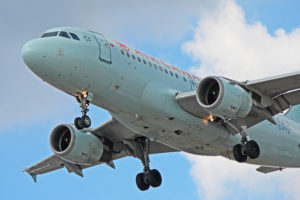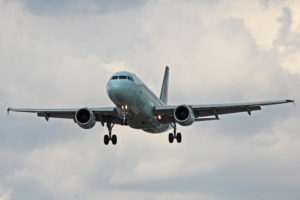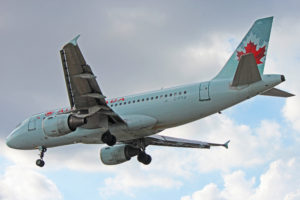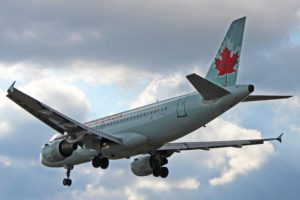 C-FYJI has been in the Air Canada fleet since 1997. Since 2013, the Airbus A319-100 has had more than its fair share of mechanical issues. More on that below. We photographed this A319 on September 14, 2017 while plane spotting at Toronto Pearson International Airport (YYZ).
C-FYJI has been in the Air Canada fleet since 1997. Since 2013, the Airbus A319-100 has had more than its fair share of mechanical issues. More on that below. We photographed this A319 on September 14, 2017 while plane spotting at Toronto Pearson International Airport (YYZ).
For full-sized, high resolution versions for any of the photos in the image gallery, simply click on the individual pictures. See below for more detailed information on C-FYJI, the Airbus A319-100 model in general and the airline.
Image Gallery
C-FYJI
Airbus A319-100
Air Canada
Resources
C-FYJI Air Canada Airbus A319-100 Image Gallery
C-FYJI
C-FYJI took its maiden flight on April 28, 1997 and was delivered to Air Canada on May 25, 1997. The Airbus A319-113 is one of 15 in the main fleet with three more under business charter division Air Canada Jetz. The aircraft is configured for a maximum total of 120 passengers with 14 seats in business class and 106 more seats in economy class.
The airliner has certainly had some issues since 2013, and especially since mid 2016. On September 18, 2013, C-FYJI was flying from Calgary, Alberta to Toronto, Ontario. Climbing out of Calgary, multiple electrical systems failed on two occasions. Crew decided to divert back to Calgary, landing safely just over a half hour after departing. The #1 generator control unit was replaced.
On March 10, 2016, the Airbus A319-100 was flying from Toronto to Bermuda. At 39,000 feet, 250 miles southeast of New York City, the aircraft experienced a stall in the left side engine. After diverting to John F. Kennedy International Airport (JFK), the hyromechanical unit and the electronic engine control unit were replaced.
A few months later, on May 14, 2016, C-FYJI was flying from Montreal, Quebec to Toronto, Ontario. On the initial climb, the crew began to have problems with the right side engine. First, they received a failure of fire loop A indication, followed by a fire warning for the that engine. After leveling off at 5,000 feet, the aircraft diverted back to Montreal for a safe landing. This resulted from a loose bleed air collar sheath releasing heat and triggering the fire warning.
On December 10, 2016, the A319 was flying from Edmonton, Alberta to Vancouver, British Columbia. Climbing out of Edmonton, crew received an indication that the right side engine’s thrust reversers had unlocked. The climb was halted at 6,000 feet and the aircraft diverted back to Edmonton for a safe landing. As a result, the #2 engine thrust reverser hydraulic control unit and the upper blocker door latch were replaced.
Moving into 2017, C-FYJI was flying from New York LaGuardia to Toronto on May 2. On final approach to Toronto Pearson International Airport, the crew received a HYD G SYS LO QTY message when they selected landing gear down. The aircraft continued for a safe landing but had to be towed to the terminal. The result was the replacement of the right side main gear up lock flex line.
Most recently, on June 3, 2017, the Airbus A319-100 was flying from Antigua to Toronto. At 34,000 feet, 290 miles northwest of San Juan, Puerto Rico, a problem arose involving the right side fuel feed and engines could only be fed by the left side and centre fuel tanks. The aircraft was diverted to San Juan for a safe landing.
Airbus A319-100
The maiden flight for the Airbus A319-100 took place on August 25, 1995 and the variant of the Airbus A320 Family was introduced with Swissair in 1996. This is the shortened version of the initial A320 variant at 34 metres or 111 feet in length. The wingspan is 36 metres or 118 feet and the aircraft stands 12 metres or 39 feet in height at the tail. The flight range is 6,950 kilometres.
Air Canada
Air Canada was founded in 1937 as Trans Canada Air Lines and switched to its current name in 1965. The airline has a fleet of around 175 aircraft flying to over 200 destinations around the world. With subsidiaries added in, those numbers increase to over 400 airliners flying to 350 destinations worldwide. The largest in the fleet is the Boeing 777-300ER while the most numerous is the Airbus A320-200.
Headquartered at Montreal Pierre Elliott Trudeau International Airport (YUL) in Dorval, Quebec, the airline is a founding member of the Star Alliance. Other founding members include Lufthansa, Scandinavian Airlines, Thai Airways and United Airlines. There are now 27 member airlines in the alliance.
Resources




